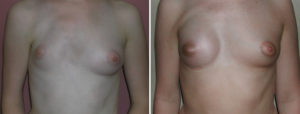Background: Poland’s syndrome is a well recognized congenital body deformity that affects the chest wall and upper extremity. It is almost always affects just one side of the body, most commonly the right side, and affects men more than women. There is a hypoplasia of the chest muscle in both men and women and lack of a breast mound in women. Despite the chest wall deficiency a nipple-areolar complex almost always is present albeit displaced superiorly and laterally from the opposite side.
Reconstruction of the breast mound in women with Poland’s syndrome is the mainstay of treatment. Since the breast mound is always absent, an implant is commonly used. There may be a role for injection fat grafting in some women but an implant produces a more predictable and stable result.
Because the chest wall is underdeveloped, creation of a breast mound with an implant will come with some inherent asymmetries. Most noticeable is the more highly positioned nipple-areolar complex. As the breast mound is created the nipple-areolar asymmetry will become more noticeable. Its superolateral position can become accentuated as the new breast mound pushes it even higher. In addition the tighter skin of the hypoplastic breast makes the implanted mound look rounder than the opposite normal breast.
Case Study: This 17 year-old female presented with Poland’s syndrome affecting her right side. She had a very small breast mound with a large nipple-areolar complex that was a large as the opposite normal side although more highly positioned. Her pectoralis muscle was also affected as it was shortened and created a band across the axilla when she lifted her arm away from her body.

Her breast implant reconstruction results for a Poland’s syndrome patient is better than many other such patients. This is undoubtably due to the more mild presentation of her Poland’s syndrome. This is evident before surgery with an affected nipple-areolar complex, that while malpositioned, is of normal size. These more favorable tissue characteristics bode well for congenital breast reconstruction efforts
Highlights:
1) Poland’s syndrome affects breast mound development and nipple-areolar positioning.
2) An implant is the standard approach for breast reconstruction in this congenital breast deformity.
3) Breast symmetry is never achieved in the Poland’s patient due to the hypoplastic tissues on the affected side.
Dr. Barry Eppley
Indianapolis, Indiana



